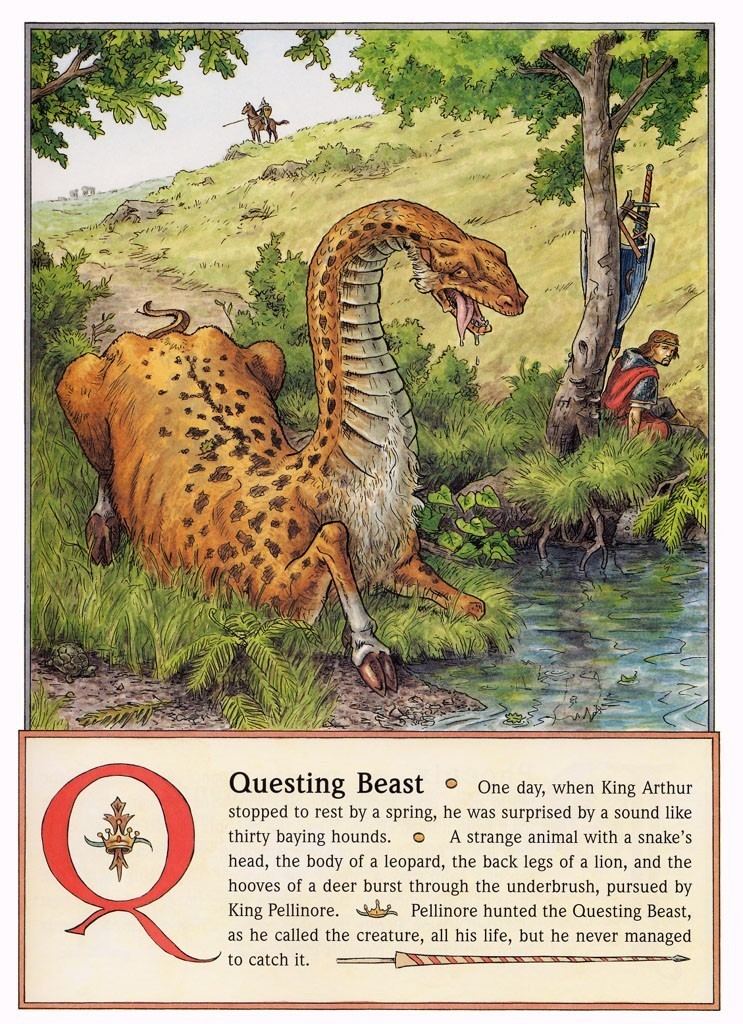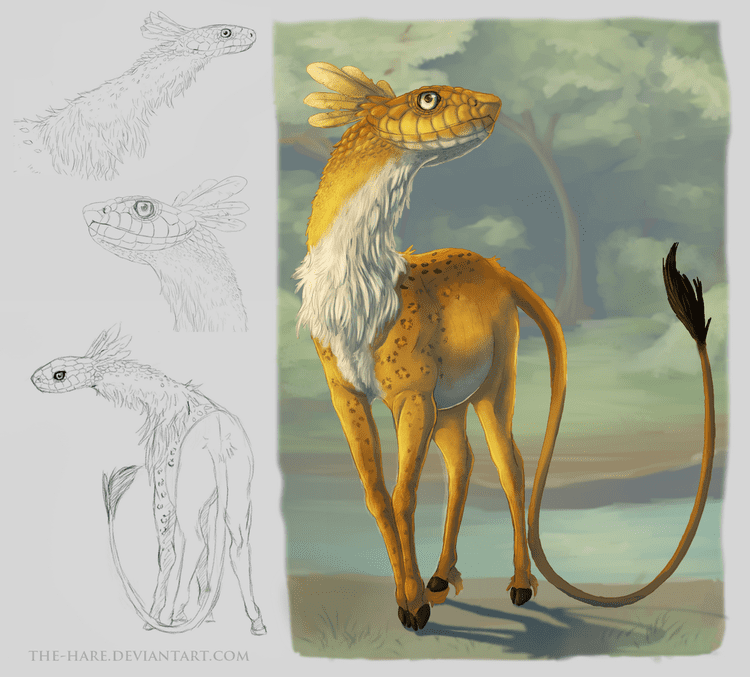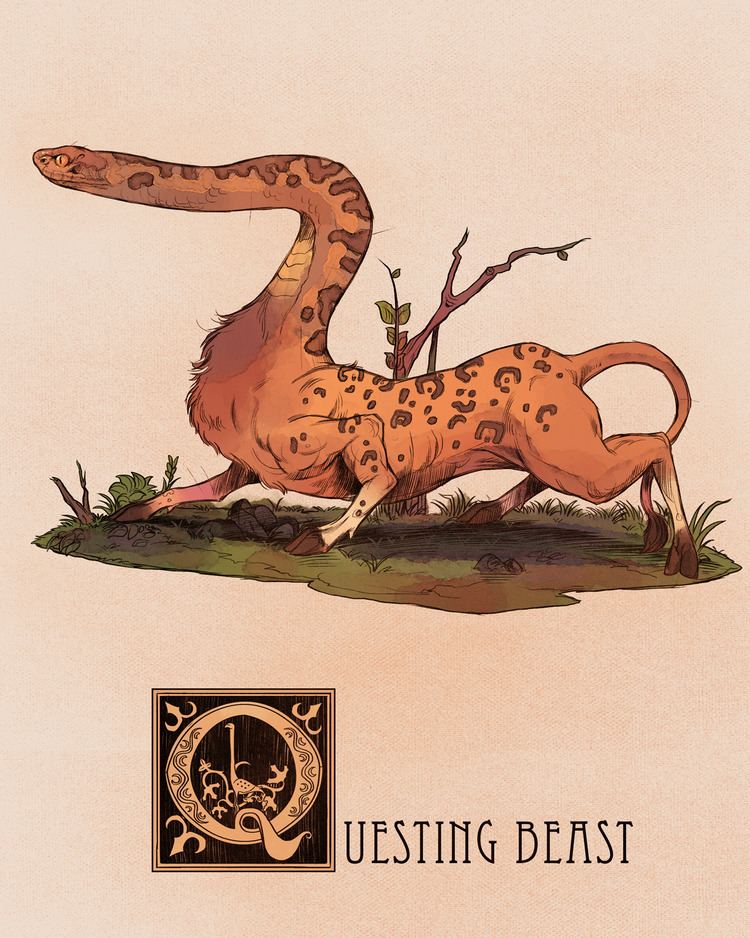 | ||
Similar Pellinore, Sir Ector, King Lot, Gaheris, Sir Kay | ||
The Questing Beast, or the Beast Glatisant (Barking Beast), is a monster from Arthurian legend. It is the subject of quests undertaken by famous knights such as King Pellinore, Sir Palamedes, and Sir Percival.
Contents
- Destiny the taken king questing beast auto rifle
- Early accounts
- Other appearances
- Modern versions
- References

The strange creature has the head and neck of a snake, the body of a leopard, the haunches of a lion, and the feet of a hart. Its name comes from the great noise that it emits from its belly, a barking like "thirty couple hounds questing". 'Glatisant' is related to the French word glapissant, 'yelping' or 'barking', especially of small dogs or foxes.

The questing beast is a variant of the mythological medieval view on giraffes, whose generic name of Camelopardalis originated from their description of being half camel and half leopard.

Destiny the taken king questing beast auto rifle
Early accounts

The first accounts of the beast are in the Perlesvaus and the Post-Vulgate Suite du Merlin. The Post-Vulgate's account, which is taken up in Thomas Malory's Le Morte d'Arthur, has the Questing Beast appear to King Arthur after he has had an affair with his half-sister Morgause and begotten Mordred (they did not know that they were related when the incestuous act occurred).

Arthur sees the beast drinking from a pool just after he wakes from a disturbing dream that foretells Mordred's destruction of the realm (no noise of hounds from the belly is emitted while it is drinking). He is then approached by King Pellinore who confides that it is his family quest to hunt the beast. Merlin reveals that the Questing Beast had been born of a human woman, a princess who lusted after her own brother. She slept with a devil who had promised to make the boy love her, but the devil manipulated her into accusing her brother of rape. Their father had him torn apart by dogs as punishment. Before he died, however, he prophesied that his sister would give birth to an abomination that would make the same sounds as the pack of dogs that was about to kill him.
The beast has been taken as a symbol of the incest, violence, and chaos that eventually destroys Arthur's kingdom.
Other appearances
The Perlesvaus offers an entirely different depiction of the Questing Beast than the best known one, given above. There, it is described as pure white, smaller than a fox, and beautiful to look at. The noise from its belly is the sound of its offspring who tear the creature apart from the inside; the author takes the beast as a symbol of Christ, destroyed by the followers of the Old Law, the Twelve Tribes of Israel.
Gerbert de Montreuil provides a similar vision of the Questing Beast in his Continuation of Perceval, the Story of the Grail, though he says that it is "wondrously large" and interprets the noise and subsequent gruesome death by its own offspring as a symbol of impious churchgoers who disturb the sanctity of Mass by talking.
Later in the Post-Vulgate, the Prose Tristan, and the sections of Malory based on those works, Saracen knight Sir Palamedes hunts the Questing Beast. It is a futile venture, much like his love for Sir Tristan's paramour Iseult, offering him nothing but hardship. In the Post-Vulgate, his conversion to Christianity allows him relief from his endless worldly pursuits, and he finally slays the creature during the Grail Quest after he, Percival, and Galahad have chased it into a lake.
The Questing Beast appears in many later works as well, including stories written in French, Galician, Spanish, and Italian.
Modern versions
T. H. White re-envisions the Questing Beast's role in his novel The Once and Future King. As King Pellinore describes it, the hunt of the beast has always been the burden of the Pellinores, and all Pellinores are in fact trained for the hunt from birth—a training which does not seem to extend much beyond finding the beast's fewmets. (Pellinore is more of a comic character as described by White than a great hunter or knight.) Having searched fruitlessly all his life for the beast, Pellinore is convinced by his friend Sir Grummore Grummursum to drop his quest. However, it turns out later that the beast is pining away for lack of attention, so King Pellinore nurses it back to health and resumes his Sisyphean hunt. This account also appears in slightly different form in the original version of The Sword in the Stone. There, King Pellinore is imprisoned by Galapas the giant, but he is saved by the Beast who turns up to rescue him—as well as Merlin and Arthur, who happen to be there at the time. Galapas ends up barricaded in his topmost tower, shrieking "let go of me you awful animal", and shouting to be rescued by the Fire Brigade. Later, the Beast falls in love with Sir Palomides, who briefly disguised himself and Sir Grummore as the beast herself in order to raise Pellinore's spirits when he is pining for his lover. White explains that this is why it is Palomides who is seen pursuing the beast later in Malory's work.
The Questing Beast appears in "Le Morte d'Arthur", the season finale of Season 1 of the BBC's series Merlin.
The Questing Beast also appears in the Thursday Next series by Jasper Fforde, although it is not described. Here it is also hunted by King Pellinore as part of his family's tradition and burden.
